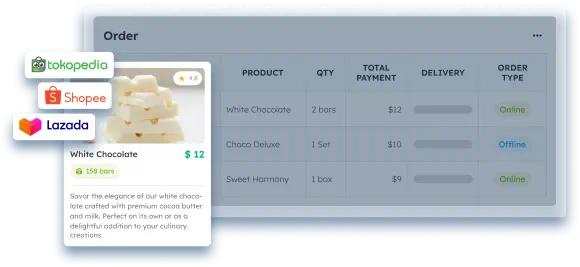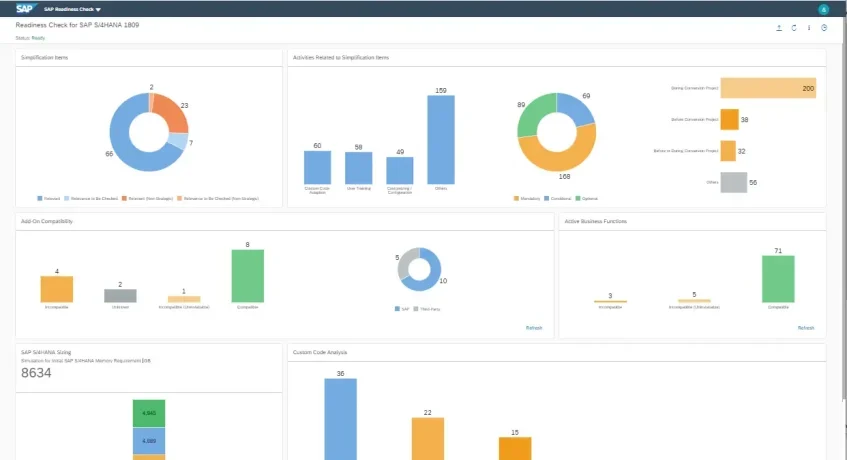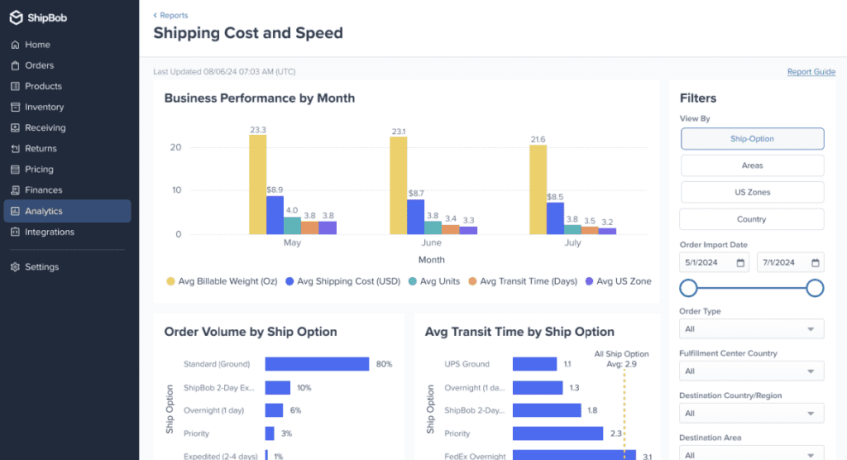Retail businesses in Singapore face rising demand, labor shortages, high rental costs, and competition. To stay competitive, many are adopting order fulfillment software to streamline operations and efficiently meet customer expectations.
Singapore’s e-commerce market has grown significantly, with projections ranging from US$8.2 billion in 2022 to US$11 billion by 2025, according to the ITA Government. This spike emphasizes the necessity for effective order fulfillment solutions to keep up with rising demand.
We’ll look at how the appropriate e-commerce order fulfillment software can completely transform your operations, including the benefits, essential features, and top order fulfillment software options, such as ScaleOcean, NetSuite, SAP S/4HANA, and more.
- Order fulfillment software enables businesses to manage the entire process, from the moment a customer places an order to delivery.
- Discover the top order fulfillment software options for your business needs, such as ScaleOcean, NetSuite, SAP S/4HANA, Cin7 Omni, and more
- To choose the right fulfillment software, assess your business size, consider your fulfillment method, evaluate key features, and check for critical integrations with existing systems.
- ScaleOcean’s retail ERP software is one of the best software options, providing a unified solution with real-time tracking, automation, and data insights.

What is Order Fulfillment Software?
Order fulfillment software enables businesses to manage the entire process, from the moment a customer places an order to delivery. It connects online stores with warehouses, managing inventory, packing, shipping, and returns to ensure everything runs smoothly.
Without this software, firms rely on spreadsheets and manual processes, which cause errors and delays in e-commerce. Order fulfillment software automates processes and provides a centralized view of the operation, resulting in faster and more accurate order fulfillment.
Key Benefits of Using Fulfillment Software in Singapore’s Competitive Market
In Singapore’s competitive market, fulfillment software is critical for increasing efficiency and managing everything from inventory to shipping. It lowers operational costs, allows employees to focus on more strategic tasks, and promotes long-term growth. Here are the main advantages of using fulfillment software:
1. Increased Efficiency and Accuracy
Manual order processing is just so slow, and it’s always full of chances for human error, which, as we know, can get really costly. Think about it, an employee picking the wrong item or keying in a bad address. It truly happens all the time. Good order management software automates steps and reduces mistakes.
This kind of automation means orders get processed much faster, right from when they’re placed until they’re shipped out the door. The system can even guide your team to the most efficient picking paths within the warehouse. It’s about ensuring your team works smarter, not harder, to deliver products efficiently.
2. Improved Customer Experience
We all know a happy customer is a repeat customer, and honestly, fulfillment plays such a huge part in keeping them happy. When orders consistently arrive on time and are accurate, it naturally builds trust and loyalty with your brand. This is truly where fulfillment software really shines, making sure everything is consistent.
This software also gives customers real-time tracking updates, so they know exactly where their package is at any given moment. That kind of transparency really cuts down on customer anxiety and, importantly, reduces those “where is my order?” support tickets. It may seem simple, but it greatly impacts the overall experience.
3. Data-Driven Decision-Making
Guesswork has no place in modern retail, especially with inventory and sales. You need data to make smart decisions. This software excels in providing insights into sales trends, inventory, and fulfillment times. According to the State Government, Singapore aims for net-zero by 2050, facing energy diversification challenges.
Armed with this data, you can make much more informed decisions about what products to stock and the best times to run promotions. It helps you easily identify your best-selling items and, crucially, pinpoint any bottlenecks in your fulfillment process. This insight is crucial for staying competitive and making strategic business decisions.
4. Prevents Stockouts and Overselling
Honestly, there’s truly nothing worse than a customer ordering something, only to discover it’s actually out of stock. This common issue, known as overselling, can seriously damage your brand’s reputation, and it often happens when inventory levels aren’t properly synced across all your sales channels.
Good e-commerce order fulfillment software gives you this really clear, centralized view of all your inventory in real-time, which is a game-changer. It automatically updates stock levels across your website, marketplaces, and even physical stores, the very second an item is sold.
5 “Must-Have” Order Fulfillment Software Features to Look For

With so many order fulfillment software alternatives available, it’s critical to prioritize the key aspects that drive retail success. Choosing the correct features ensures that your software addresses problems and facilitates growth. Here are the must-have features to consider:
1. Integrations
Your order fulfillment software must seamlessly interface with systems like Shopify, WooCommerce, accounting tools, and shipping providers. A seamless connection with e-commerce platforms, accounting software, and local/international shipping carriers is essential. Without it, manual data entry can cause delays and inaccuracies.
When choosing retail management software, look for solutions with a robust API or pre-built connectors for your technology stack. This enables automatic data transfer, saving time and reducing costly errors in the process.
2. Real-Time Visibility
Knowing exactly what’s going on with your inventory and orders at any given moment is absolutely non-negotiable for order management and fulfillment. True real-time visibility lets you instantly see current stock levels, order statuses, and how far along fulfillment is, which is just critical for managing your operations and tackling issues fast.
And this feature isn’t solely for your benefit. It significantly impacts your customers as well. Giving them accurate, up-to-the-minute tracking information really builds confidence and makes their overall experience much better, which is a win-win for everyone.
3. Automation
Let’s be honest, the main reason for investing in fulfillment software is to cut down on manual effort, so automation is clearly a central feature here. You should definitely seek out a system that can handle repetitive tasks automatically, things like order routing, picking the best carrier, and even printing shipping labels.
Effective automation also extends to things like automatically sending out shipping confirmation emails to your customers, which is a nice touch. The more processes you can automate, the more efficient and scalable your entire e-commerce order fulfillment process becomes.
4. Returns Management
Returns are just a fact of life in e-commerce, and how efficiently you manage them can seriously impact customer loyalty. It’s a make-or-break situation. A good fulfillment software should include a returns management module, or reverse logistics, to streamline the process for everyone.
This specific feature should enable you to easily generate return labels, keep tabs on incoming returns, and efficiently process refunds or exchanges. Simplifying returns turns a negative experience into a positive one, showing customers you value their business and stand by your products.
5. Reporting and Analytics
Data, simply put, is power, and your order fulfillment software absolutely needs to equip you with plenty of it. Robust reporting and analytics features are what truly help you get a handle on your overall business performance. Easily track metrics like order accuracy, fulfillment times, and shipping costs.
This kind of comprehensive information is invaluable for pinpointing areas that need improvement and for making much smarter, data-driven business decisions. You’ll gain insights into things like which products see the most returns or which shipping carriers consistently prove to be the most reliable choice for your operations.
6 Best Order Fulfillment Software in Singapore
Choosing the best order fulfillment software in Singapore is dependent on your company’s needs, size, industry, and budget. From all-in-one ERP systems for large corporations to platforms for growing e-commerce brands, research is essential. Here are the six top order fulfillment software alternatives to consider:
1. ScaleOcean’s Retail Order Fulfillment Software

ScaleOcean’s retail ERP software addresses modern market challenges by consolidating all business operations into a single system. It eliminates inefficiencies and errors by optimizing procedures in inventories, orders, accounting, and CRM.
An all-in-one ERP that combines order fulfillment, inventory management, CRM, procurement, and finance. It establishes a single source of truth for the whole corporate operation, ensuring consistent data and efficient procedures beyond fulfillment.
ScaleOcean offers a free demo that allows organizations to examine its order fulfillment capabilities in depth. Companies may optimize operations using insights from real-time tracking and analytics, while simultaneously employing the CTC grant to lessen implementation challenges.
Key Features:
- Real-Time Inventory Management: Tracks stock across multiple locations to prevent stockouts and overselling.
- Order Processing Automation: Streamlines order handling from multiple sales channels efficiently.
- Shipping Management: Integrates with carriers and supports label printing for smooth fulfillment.
- Reporting and Analytics: Provides insights on inventory, orders, and overall business performance.
- System Integration: Connects with CRM, procurement, accounting, and other business systems for a unified operation.
| Pros | Cons |
|---|---|
|
|
Best For: ScaleOcean is ideal for developing and established organizations in Singapore, as it eliminates data silos by providing a unified platform to manage the whole supply chain, streamlining operations, and enhancing efficiency for businesses at any stage of growth.
2. NetSuite Order Management
NetSuite, as many might know, is quite a well-established name within the whole ERP landscape, and its order management module is, well, very great indeed. It’s a strong option for larger businesses needing scalability and customization, especially for complex fulfillment setups like shipping from multiple warehouses or store locations.
Smaller businesses may find it difficult to implement due to its complexity and length. However, for larger businesses that require a comprehensive system, it provides strong order management capabilities that can handle complex operations effectively.
Key Features:
- Scalable and customizable to suit various business needs
- Strong integration capabilities with other enterprise systems
- Manages complex fulfillment setups like multiple warehouses
- Provides detailed reporting and analytics for better decision-making
- Centralizes order management across all channels
| Pros | Cons |
|---|---|
|
|
Best For: Large companies or enterprises that need a feature-rich and highly adaptable order management system are the ideal candidates for NetSuite. Businesses with complicated fulfillment requirements, including those with several warehouses or retail locations, will find it ideal.
3. SAP S/4HANA Cloud Order Platform

SAP is yet another really big name in the enterprise software arena, generally setting its sights on serving those very large corporations. Their S/4HANA Cloud platform comes packed with some truly good features for managing orders and fulfillment, which is quite impressive.
Much like NetSuite, investing in SAP is a pretty significant undertaking and, frankly, it’s probably going to be overkill for most small to medium-sized businesses out there. It’s really well-regarded for its great analytical tools and its capacity to process absolutely massive volumes of data, which is crucial for big players.
Key Features:
- Cloud-based platform that integrates order management and fulfillment
- Powerful analytical tools to process large volumes of data
- Real-time data processing for faster decision-making
- Scalable to support large-scale operations
- Advanced order tracking and reporting capabilities
| Pros | Cons |
|---|---|
|
|
Best For: Large organizations with intricate, enterprise-level requirements, especially those that need strong data processing and analytics capabilities to handle enormous volumes of data and operations, are best suited for SAP S/4HANA Cloud.
4. Cin7 Omni E-Commerce Fulfillment System
Cin7 Omni tends to be a pretty popular option, especially for those growing multichannel brands out there. It’s actually built from the ground up to tackle the complexities of selling across lots of different platforms, whether that’s your online store, various marketplaces, or even your physical retail locations, which can get tricky.
The platform itself is well-known for its robust inventory management features, alongside a pretty wide array of integrations, which is helpful for many businesses. It genuinely assists companies in automating their whole order fulfillment workflows and doing a great job at preventing those frustrating stockouts.
Key Features:
- Designed for multichannel retailers, integrating various sales channels
- Robust inventory management features
- Multiple platform integrations (marketplaces, retail, e-commerce)
- Automates order fulfillment workflows
- Provides detailed reporting on sales and inventory
| Pros | Cons |
|---|---|
|
|
Best For: For expanding multichannel companies that want a single system to handle sales across several channels, such as physical stores, marketplaces, and online retailers, Cin7 Omni is perfect. Businesses that prioritize inventory control and expediting order fulfillment will find it most effective.
5. ShipBob Fulfillment Software

ShipBob is actually a little bit unique in this list because it acts as both a 3PL, which is a third-party logistics provider, and also offers its own software platform. So, if your goal is to pretty much outsource your entire fulfillment process, they’re set up to store your inventory, then pick, pack, and even ship your orders directly for you.
This particular setup turns out to be a strong choice for businesses that just don’t want the hassle or the cost of managing their own warehouse operations. You essentially gain access to a professional logistics network and some pretty powerful technology, all without the usual overhead that comes with it.
Key Features:
- Combines 3PL services with software for end-to-end fulfillment
- Inventory storage and management
- Automated pick, pack, and ship services
- Real-time order tracking and reporting
- Integration with major e-commerce platforms
| Pros | Cons |
|---|---|
|
|
Best For: Businesses that wish to outsource every step of their fulfillment process, including packaging, shipping, and inventory storage, should use ShipBob. For e-commerce businesses that want a simple way to handle fulfillment without having to invest in their own warehouses, it works effectively.
6. ShipMonk Fulfillment Service
Quite similar to ShipBob, ShipMonk also operates as another tech-enabled 3PL provider in the market. They essentially offer a comprehensive suite of fulfillment services, all seamlessly combined with a pretty user-friendly software platform, making it a bit easier to manage.
This whole setup lets you manage your inventory, all your orders, and even the shipping aspects from a single dashboard, while they take care of all the actual physical work behind the scenes. ShipMonk has built a reputation for really focusing on helping e-commerce brands scale up their operations effectively, which is a key benefit.
Key Features:
- Tech-enabled 3PL provider with fulfillment software
- Real-time tracking and order updates
- Unified dashboard for managing inventory and orders
- Integration with popular e-commerce platforms
- Scalable for businesses looking to grow their operations
| Pros | Cons |
|---|---|
|
|
Best For: For expanding e-commerce companies wishing to outsource fulfillment operations, ShipMonk is perfect. It is appropriate for companies that wish to grow without the hassle of running their own warehouses because of its user-friendly platform and robust logistics capabilities.

How to Choose the Right Fulfillment Software
Choosing the right order fulfillment software is critical because it will have a long-term impact on your business operations. Consider crucial considerations while looking for a solution that will suit your current demands while also scaling up for future expansion. Here are the essential points to help you make a decision:
1. Assess Your Business Size and Order Volume
Honestly, what a small startup shipping, say, 50 orders a month needs is vastly different from a large retailer moving thousands. You really need to be realistic about your current order volume and, crucially, your projected growth over the next few years.
Many platforms, which is great, offer tiered pricing that’s based right on your order volume, letting you start small and easily upgrade as your business expands. There’s no real reason to pay for enterprise-level features if your company isn’t operating at that scale yet, so aim to find a solution that precisely matches your current scale of operations.
2. Consider Your Fulfillment Method
Think about how you’re actually getting orders out the door right now. Are you managing your own warehouse operations in-house, working with a third-party logistics (3PL) provider, or perhaps utilizing a dropshipping model? The method you’ve chosen for your retail order fulfillment directly dictates the specific kind of software capabilities you’ll need.
If you’re handling fulfillment in-house, you need software with robust warehouse management. Are you self-fulfilling, using a 3PL provider, or dropshipping? For 3PLs, ensure the software integrates seamlessly with their platform to support your fulfillment strategy.
3. Evaluate and Prioritize Key Features
Now, take a fresh look at those “must-have” features you identified and really decide which ones matter most for your business. Are you constantly wrestling with inventory accuracy, or is returns management often your biggest headache? Making a concise list of your absolute top priorities here is a smart move.
Once that list is ready, use it to properly evaluate various order management and fulfillment software options out there. Doing a demo is truly an excellent way to see these features in real-time and ask very specific questions, but don’t get sidetracked by flashy tools you’ll never actually use.
4. Check for Critical Integrations
Remember, your fulfillment software isn’t some isolated island. It absolutely needs to talk to your other crucial business systems. List all platforms you use, like your e-commerce site, marketplaces, and accounting software, then ensure your order fulfillment solution integrates seamlessly with them.
A failure to secure critical integrations means you’ll end up with frustrating data silos and constant manual workarounds, which honestly defeats the whole purpose of getting software in the first place. Ensure the integrations are robust and well-supported, as this step is non-negotiable.
Conclusion
In Singapore’s competitive retail sector, effective order fulfillment is critical to success. The appropriate software improves efficiency, accuracy, and customer experience, enabling organizations to stay ahead. It prevents stockouts and gives useful data for making educated growth decisions.
ScaleOcean, a renowned vendor, provides strong solutions for order fulfillment and inventory management. Businesses can easily optimize processes using their retail ERP software. ScaleOcean offers a free demo to anyone interested in learning more about how their solutions might help you streamline your fulfillment process.
FAQ:
1. What is the difference between inventory management and order fulfillment software?
Inventory management software tracks stock levels, manages warehouses, and predicts future demand, ensuring optimal stock availability. Order fulfillment software focuses on processing customer orders, from picking and packing to shipping, ensuring timely delivery and order accuracy.
2. How does order fulfillment software help manage customer returns?
Order fulfillment software simplifies returns by generating return labels, tracking the status of returns, and facilitating the refund or exchange process. It enables businesses to efficiently handle returns and provide customers with a smooth, hassle-free experience.
3. Can ScaleOcean’s order fulfillment software integrate with local Singaporean or regional couriers?
Yes, ScaleOcean’s order fulfillment software is designed to integrate seamlessly with both local and regional couriers in Singapore. This integration enables businesses to automate the shipping process, track shipments, and streamline their fulfillment workflows for greater efficiency.
4. What are the three types of order fulfillment?
The three primary types of order fulfillment are in-house fulfillment, where businesses handle their own inventory and shipping, third-party logistics (3PL), which outsources fulfillment to a partner, and dropshipping, where products are shipped directly from the supplier to the customer.







 PTE LTD..png)
.png)

.png)








.png)
.png)
















